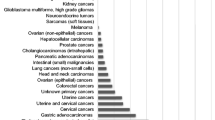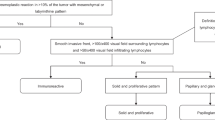Abstract
Oncogenic activation of the mitogen-activated protein kinase (MAPK) pathway due to KRAS or BRAF gain-of-function mutation is frequently found in ovarian serous borderline tumor (SBT) and their extraovarian implants. We investigated mutational status of KRAS and BRAF of the primary ovarian SBTs that had a high stage presentation in correlation with clinical outcome. Among 39 consecutive primary SBTs with either invasive implants (20 cases) or non-invasive implants (19 cases), KRAS and BRAF mutational analysis was informative in 34 cases. Sixteen cases (47%) harbored a KRAS mutation, while 5 cases (15%) had a BRAF V600E mutation. High-stage disease (IIIC) was seen in 31% (5/16) of patients with a KRAS mutation and 39% (7/18) of patients without a KRAS mutation (p = 0.64). KRAS mutations were present in 9/16 (56%) tumors with invasive implants/LGSC versus 7/18 (39%) tumors with non-invasive implants (p = 0.31). BRAF mutation was seen in 5 cases with non-invasive implants. Tumor recurrence was seen in 31% (5/16) of patients with a KRAS mutation, compared to 6% (1/18) of patients without a KRAS mutation (p = 0.04). A KRAS mutation predicted an adverse disease-free survival (31% survival at 160 months) compared to those with wild-type KRAS (94% at 160 months; log-rank test, p = 0.037; HR 4.47). In conclusion, KRAS mutation in primary ovarian SBTs is significantly associated with a worse disease-free survival, independent of the high tumor stage or histological subtypes of extraovarian implant. KRAS mutation testing of primary ovarian SBT may servce as a useful biomarker for tumor recurrence.




Similar content being viewed by others
References
Bell KA, Smith Sehdev AE, Kurman RJ (2001) Refined diagnostic criteria for implants associated with ovarian atypical proliferative serous tumors (borderline) and micropapillary serous carcinomas. Am J Surg Pathol 25:419–432
Ahn G, Folkins AK, McKenney JK et al (2016) Low-grade serous carcinoma of the ovary: clinicopathologic analysis of 52 invasive cases and identification of a possible noninvasive intermediate lesion. Am J Surg Pathol 40:1165–1176
Ayhan A, Guvendag Guven ES, Guven S et al (2005) Recurrence and prognostic factors in borderline ovarian tumors. Gynecol Oncol 98:439–445
Park JY, Kim DY, Kim JH et al (2009) Surgical management of borderline ovarian tumors: the role of fertility-sparing surgery. Gynecol Oncol 113:75–82
Hannibal CG, Vang R, Junge J et al (2014) A nationwide study of serous “borderline” ovarian tumors in Denmark 1978–2002: centralized pathology review and overall survival compared with the general population. Gynecol Oncol 134:267–273
Longacre TA, McKenney JK, Tazelaar HD et al (2005) Ovarian serous tumors of low malignant potential (borderline tumors): outcome-based study of 276 patients with long-term (> or =5-year) follow-up. Am J Surg Pathol 29:707–723
Vang R, Hannibal CG, Junge J et al (2017) Long-term behavior of serous borderline tumors subdivided into atypical proliferative tumors and noninvasive low-grade carcinomas: a population-based clinicopathologic study of 942 cases. Am J Surg Pathol 41:725–737
McKenney JK, Balzer BL, Longacre TA (2006) Lymph node involvement in ovarian serous tumors of low malignant potential (borderline tumors): pathology, prognosis, and proposed classification. Am J Surg Pathol 30:614–624
Seidman JD, Kurman RJ (2000) Ovarian serous borderline tumors: a critical review of the literature with emphasis on prognostic indicators. Hum Pathol 31:539–557
Prat J, De Nictolis M (2002) Serous borderline tumors of the ovary: a long-term follow-up study of 137 cases, including 18 with a micropapillary pattern and 20 with microinvasion. Am J Surg Pathol 26:1111–1128
Bell DA, Longacre TA, Prat J et al (2004) Serous borderline (low malignant potential, atypical proliferative) ovarian tumors: workshop perspectives. Hum Pathol 35:934–948
Hannibal CG, Vang R, Junge J et al (2017) A nationwide study of ovarian serous borderline tumors in Denmark 1978–2002. Risk of recurrence, and development of ovarian serous carcinoma. Gynecol Oncol 144:174–180
Chui MH, Xing D, Zeppernick F et al (2019) Clinicopathologic and molecular features of paired cases of metachronous ovarian serous borderline tumor and subsequent serous carcinoma. Am J Surg Pathol 43:1462–1472
Singer G, Oldt R 3rd, Cohen Y et al (2003) Mutations in BRAF and KRAS characterize the development of low-grade ovarian serous carcinoma. J Natl Cancer Inst 95:484–486
Ho CL, Kurman RJ, Dehari R et al (2004) Mutations of BRAF and KRAS precede the development of ovarian serous borderline tumors. Cancer Res 64:6915–6918
Jones S, Wang TL, Kurman RJ et al (2012) Low-grade serous carcinomas of the ovary contain very few point mutations. J Pathol 226:413–420
Hunter SM, Anglesio MS, Ryland GL et al (2015) Molecular profiling of low grade serous ovarian tumours identifies novel candidate driver genes. Oncotarget 6:37663–37677
Krzystyniak J, Ceppi L, Dizon DS et al (2016) Epithelial ovarian cancer: the molecular genetics of epithelial ovarian cancer. Ann Oncol 27(Suppl 1):i4–i10
Anglesio MS, Arnold JM, George J et al (2008) Mutation of ERBB2 provides a novel alternative mechanism for the ubiquitous activation of RAS-MAPK in ovarian serous low malignant potential tumors. Mol Cancer Res 6:1678–1690
Xing D, Suryo Rahmanto Y, Zeppernick F et al (2017) Mutation of NRAS is a rare genetic event in ovarian low-grade serous carcinoma. Hum Pathol 68:87–91
Zuo T, Wong S, Buza N et al (2018) KRAS mutation of extraovarian implants of serous borderline tumor: prognostic indicator for adverse clinical outcome. Mod Pathol 31:350–357
Chui MH, Kjaer SK, Frederiksen K et al (2019) BRAF(V600E) -mutated ovarian serous borderline tumors are at relatively low risk for progression to serous carcinoma. Oncotarget 10:6870–6878
Tsang YT, Deavers MT, Sun CC et al (2013) KRAS (but not BRAF) mutations in ovarian serous borderline tumour are associated with recurrent low-grade serous carcinoma. J Pathol 231:449–456
WHO (2020) Classification of Tumours 5th Edition - Female Genital Tumours. (IARC Press, Lyon, France
Zhong H, Liu Y, Talmor M et al (2013) Deparaffinization and lysis by hydrothermal pressure (pressure cooking) coupled with chaotropic salt column purification: a rapid and efficient method of DNA extraction from formalin-fixed paraffin-embedded tissue. Diagn Mol Pathol 22:52–58
Dillon DA, Johnson CC, Topazian MD et al (2000) The utility of Ki-ras mutation analysis in the cytologic diagnosis of pancreatobiliary neoplasma. Cancer J 6:294–301
Metzker ML (2005) Emerging technologies in DNA sequencing. Genome Res 15:1767–1776
Mayr D, Hirschmann A, Löhrs U et al (2006) KRAS and BRAF mutations in ovarian tumors: a comprehensive study of invasive carcinomas, borderline tumors and extraovarian implants. Gynecol Oncol 103:883–887
Ardighieri L, Zeppernick F, Hannibal CG et al (2014) Mutational analysis of BRAF and KRAS in ovarian serous borderline (atypical proliferative) tumours and associated peritoneal implants. J Pathol 232:16–22
Gershenson DM, Sun CC, Westin SN et al (2022) The genomic landscape of low-grade serous ovarian/peritoneal carcinoma and its impact on clinical outcomes. Gynecol Oncol 165:560–567
Malpica A, Wong KK (2016) The molecular pathology of ovarian serous borderline tumors. Ann Oncol 27(Suppl 1):i16–i19
Silva EG, Tornos C, Zhuang Z et al (1998) Tumor recurrence in stage I ovarian serous neoplasms of low malignant potential. Int J Gynecol Pathol 17:1–6
Grisham RN, Iyer G, Garg K et al (2013) BRAF mutation is associated with early stage disease and improved outcome in patients with low-grade serous ovarian cancer. Cancer 119:548–554
Wong KK, Tsang YT, Deavers MT et al (2010) BRAF mutation is rare in advanced-stage low-grade ovarian serous carcinomas. Am J Pathol 177:1611–1617
Zeppernick F, Ardighieri L, Hannibal CG et al (2014) BRAF mutation is associated with a specific cell type with features suggestive of senescence in ovarian serous borderline (atypical proliferative) tumors. Am J Surg Pathol 38:1603–1611
Author information
Authors and Affiliations
Contributions
Dr. Austin McHenry conducted study case selection, data collection and analysis, and drafted the manuscript. Dr. Douglas Rottmann conducted initial study case selection and data collection. Dr. Natalia Buza conducted study data review and contributed to the writing of the manuscript. Dr. Pei Hui designed the study, conducted data review and analysis, and finilized the manucirpt.
Corresponding author
Ethics declarations
Ethics approval
This study has been performed in compliance with the institutional ethical standards.
Conflict of interest
The authors declare no competing interests.
Additional information
Publisher's note
Springer Nature remains neutral with regard to jurisdictional claims in published maps and institutional affiliations.
Rights and permissions
Springer Nature or its licensor (e.g. a society or other partner) holds exclusive rights to this article under a publishing agreement with the author(s) or other rightsholder(s); author self-archiving of the accepted manuscript version of this article is solely governed by the terms of such publishing agreement and applicable law.
About this article
Cite this article
McHenry, A., Rottmann, D.A., Buza, N. et al. KRAS mutation in primary ovarian serous borderline tumors correlates with tumor recurrence. Virchows Arch 483, 71–79 (2023). https://doi.org/10.1007/s00428-023-03564-z
Received:
Revised:
Accepted:
Published:
Issue Date:
DOI: https://doi.org/10.1007/s00428-023-03564-z




